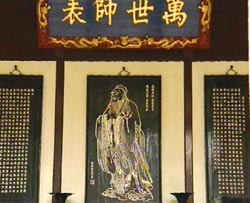Source: CCTV.com
08-02-2006 13:26


Changsha, the earliest settlement was probably founded in the first millennium BC. By 202 BC it was already a fortified city. During the Han Dynasty it was also the capital of Changsha kingdom.
The celebrated Ma-Wang-Dui Tombs of the Han Dynasty were constructed between 186 and 165 BC. The earliest tomb (no. 2), when excavated in the 1970s, had preserved the corpse of Lady Xin-Zhui in a surprisingly good condition.
During the Sui Dynasty, Changsha was a county.

Yuelu Academy was founded in AD 976 (Song Dynasty), destroyed by war in 1127, and rebuilt in 1165 (Southern Song Dynasty). The celebrated philosopher Zhu Xi taught in this school in 1165. The school was destroyed by the Mongols but restored again in the late 15th century (Ming Dynasty).
Changsha has a monsoon climate within the sub-tropical zone, with annual average temperature being 16.8°C–17.2°Celsius.
The four seasons are distinct. Summer is long and broiling, with heavy rainfall, and autumn is comfortable with abundant sunlight.
Changsha is a city that has a very long history. Changsha got its name in the time of Western Chou. In Spring and Autumn Period and Warriors States Period, Changsha was the strategic area in the southern part of Chu country. After Emperor Qin destroyed the other six countries, he unified China in 221B.C. And then separated it into 36 regions. And Changsha was set up as one.

The academy has witnessed more than a thousand consecutive years of history and is the only one of the ancient Chinese academies of Classical Learning to have evolved into a modern institution of higher learning. The historical transformation from Yuelu Academy to Hunan University can be seen as the epitome of the development of China's higher education, a change which mirrors China's education system.

As one of the four most prestigious academies over the last 1000 years in China, Yuelu Academy has been a famous institution of higher learning as well as a centre of academic activities and cultures since it was formally set up in 976 ( the Northern Song Dynasty ). The Academy, which has survived the Song, Yuan, Ming and Qing dynasties, was converted into Hunan Institute of Higher Learning in 1903. It was later renamed Hunan Normal College
In general, there are not many foreign residents in Chang Sha. However, a common place that is definitely attractive to everyone is the Hunan University and Yuelu Academy that I found some foreign teachers living and working here.
Aiwan Pavilion lies in Qingfeng Gorge and was built in A.D.1792. Its original name is Red Leaf Pavilion and later according to the poem written by Du Mu, the name was changed. Mao Zedong once played and studied here and the remaining tablet was written by Mao Zedong in the 1950s.

Lushan Temple is lies in the hillside of the mountain, It was built in A.D.268 and later was destroyed and repaired for several times, it was rebuilt in 1980s.
Today most monks living in the Buddhist temples are religious students and researchers. The everyday live inside the temple is more or less civilized.
Hunan silk embroidery design is well known for rich colors comparable to an oil painting and realism comparable to photography. The unique technique of Hunan embroidery provides a means for threads of different colors to mix naturally, resulting in a very harmonious effect.
Colorful combinations consisting of silk, floss, or cotton thread are used depending on the particular aspect of needlework appropriate to the subject form.
The early Han period (early 2nd century BC) tombs of a noble family excavated at Mawangdui are among the most important archaeological discoveries of the past quarter-century. The astonishing state of preservation of one of the tombs, including the mummified corpse of Marquess of Dai, and precious materials such as lacquer-painted wood and silk textiles. In addition, the tomb contains manuscript texts of versions of classic scriptures from early Chinese philosophical schools, the tombs also contained silk funerary paintings, which offer insights into early imperial age mythologies.


The tombs were discovered in 1972 during construction work at Mawangdui, about 4 km northeast of Changsha, and excavation was completed in 1974. The best preserved, and entirely undisturbed tomb, was that of the Marquess of Dai, or Xin Zui, buried about 180 BC, whose husband was a minor nobleman in charge of administering the region of Changsha. The tomb walls were surrounded by layers of charcoal and pounded clay, which seem to have been instrumental in keeping the moisture level constant and preventing the decay of the corpse and other tomb contents.
I was told that the Fire Temple is the best choice for tasting the local cuisine. It has over 100 years of history with various unique items in the teahouse, food court and banquet style restaurant. However there are more than one Fire Temples in changsha city, only the one on Bozi street is original.
As early as the Western Han Dynasty, 2,100 years ago, the cooking skills of Hunan cuisine reached a high standard. To make full use of its rich natural resources, the owner of Xi Hu Lou restaurant created a wide variety of delicacies. Hunan cuisine consists of more than 4,000 dishes, among which more than 300 are very famous.

Changsha people is well know for their easy-going attitude. Come to a luxury style of spending the spare time, there are many options. Dinning in a cultural featured restaurant is a treat, or sitting in a quite local teahouse, zipping a cup of green tea is one of my favorite picks.
In the weekend, Jie Fang Street in downtown area is the most fully occupied district. Many bars and nightclubs will work diligently on showcase their specialties. Due to the entire hardworking week, I passed this chance of visiting, but you can count on me, I will be back.
Editor:Chen

